Miele G 879 SCVI User Manual
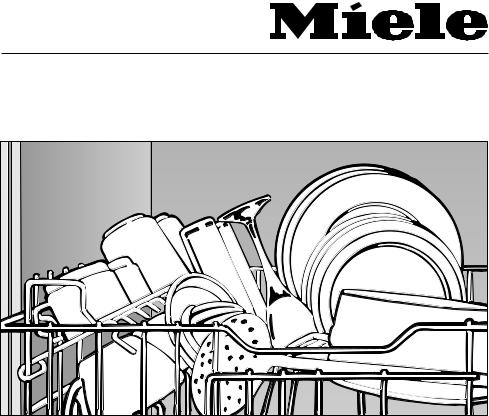
Operating and installation instructions
Dishwasher G 879 SCVi
In order to protect yourself and avoid damage to your machine, it is absolutely necessary to read the operating and installation instructions prior to installation and operation.
]
M.-Nr. 05 038 402

Contents
Guide to the appliance. . . . . . . . . . . . . . . . . . . . . . . . . . . . . . . . . . . . . . . . . . . . . . 4 View of the machine . . . . . . . . . . . . . . . . . . . . . . . . . . . . . . . . . . . . . . . . . . . . . . . . . 4 Control panel . . . . . . . . . . . . . . . . . . . . . . . . . . . . . . . . . . . . . . . . . . . . . . . . . . . . . . 5
Important safety instructions . . . . . . . . . . . . . . . . . . . . . . . . . . . . . . . . . . . . . . . . 6
Caring for the environment . . . . . . . . . . . . . . . . . . . . . . . . . . . . . . . . . . . . . . . . . . 8
Before using for the first time . . . . . . . . . . . . . . . . . . . . . . . . . . . . . . . . . . . . . . . . 9
Opening and closing the door . . . . . . . . . . . . . . . . . . . . . . . . . . . . . . . . . . . . . . 10
Water Softener . . . . . . . . . . . . . . . . . . . . . . . . . . . . . . . . . . . . . . . . . . . . . . . . . . . 11 Programming the water hardness . . . . . . . . . . . . . . . . . . . . . . . . . . . . . . . . . . . . . 12 To programme the water hardness . . . . . . . . . . . . . . . . . . . . . . . . . . . . . . . . . . 13 To check the programmed water hardness: . . . . . . . . . . . . . . . . . . . . . . . . . . . 14 Setting the water hardness selector inside the wash cabinet. . . . . . . . . . . . . . 15 Filling the salt reservoir. . . . . . . . . . . . . . . . . . . . . . . . . . . . . . . . . . . . . . . . . . . . . . 16 Salt indicator. . . . . . . . . . . . . . . . . . . . . . . . . . . . . . . . . . . . . . . . . . . . . . . . . . . . . . 17 Bypassing the Salt indicator lamp . . . . . . . . . . . . . . . . . . . . . . . . . . . . . . . . . . 17
Adding rinse aid . . . . . . . . . . . . . . . . . . . . . . . . . . . . . . . . . . . . . . . . . . . . . . . . . . 18 Setting the dosage. . . . . . . . . . . . . . . . . . . . . . . . . . . . . . . . . . . . . . . . . . . . . . . . . 19
Loading the dishwasher . . . . . . . . . . . . . . . . . . . . . . . . . . . . . . . . . . . . . . . . . . . 20 Loading examples.. . . . . . . . . . . . . . . . . . . . . . . . . . . . . . . . . . . . . . . . . . . . . . . . . 21 Upper basket. . . . . . . . . . . . . . . . . . . . . . . . . . . . . . . . . . . . . . . . . . . . . . . . . . . 21 Bottom basket. . . . . . . . . . . . . . . . . . . . . . . . . . . . . . . . . . . . . . . . . . . . . . . . . . 21 Cutlery tray. . . . . . . . . . . . . . . . . . . . . . . . . . . . . . . . . . . . . . . . . . . . . . . . . . . . . 22 Coffee bar. . . . . . . . . . . . . . . . . . . . . . . . . . . . . . . . . . . . . . . . . . . . . . . . . . . . . . . . 23 Adjustable cup racks. . . . . . . . . . . . . . . . . . . . . . . . . . . . . . . . . . . . . . . . . . . . . . . 23 Insert for glasses . . . . . . . . . . . . . . . . . . . . . . . . . . . . . . . . . . . . . . . . . . . . . . . . . . 23 Adjusting the upper basket.. . . . . . . . . . . . . . . . . . . . . . . . . . . . . . . . . . . . . . . . . . 24
Items not suitable for dishwashers . . . . . . . . . . . . . . . . . . . . . . . . . . . . . . . . . . 25
Adding detergent . . . . . . . . . . . . . . . . . . . . . . . . . . . . . . . . . . . . . . . . . . . . . . . . . 26
Choosing a programme . . . . . . . . . . . . . . . . . . . . . . . . . . . . . . . . . . . . . . . . . . . . 27
Programme chart . . . . . . . . . . . . . . . . . . . . . . . . . . . . . . . . . . . . . . . . . . . . . . . . . 28
Operating the dishwasher . . . . . . . . . . . . . . . . . . . . . . . . . . . . . . . . . . . . . . . . . . 30 Turning on. . . . . . . . . . . . . . . . . . . . . . . . . . . . . . . . . . . . . . . . . . . . . . . . . . . . . . . . 30 Starting a programme. . . . . . . . . . . . . . . . . . . . . . . . . . . . . . . . . . . . . . . . . . . . . . . 30 End of Programme. . . . . . . . . . . . . . . . . . . . . . . . . . . . . . . . . . . . . . . . . . . . . . . . . 30 Interrupting a programme. . . . . . . . . . . . . . . . . . . . . . . . . . . . . . . . . . . . . . . . . . . . 31 Changing a programme. . . . . . . . . . . . . . . . . . . . . . . . . . . . . . . . . . . . . . . . . . . . . 31 Turning the dishwasher off. . . . . . . . . . . . . . . . . . . . . . . . . . . . . . . . . . . . . . . . . . . 31
2

Contents
Unloading the dishwasher. . . . . . . . . . . . . . . . . . . . . . . . . . . . . . . . . . . . . . . . . . 32
Additional features. . . . . . . . . . . . . . . . . . . . . . . . . . . . . . . . . . . . . . . . . . . . . . . . 33 Top Solo . . . . . . . . . . . . . . . . . . . . . . . . . . . . . . . . . . . . . . . . . . . . . . . . . . . . . . . . . 33 Heated drying . . . . . . . . . . . . . . . . . . . . . . . . . . . . . . . . . . . . . . . . . . . . . . . . . . . . 34 Turning off “Heated drying”. . . . . . . . . . . . . . . . . . . . . . . . . . . . . . . . . . . . . . . . 34 Turning on “Heated drying”. . . . . . . . . . . . . . . . . . . . . . . . . . . . . . . . . . . . . . . . 34 End of programme notification. . . . . . . . . . . . . . . . . . . . . . . . . . . . . . . . . . . . . . . . 35 Turning the buzzer off . . . . . . . . . . . . . . . . . . . . . . . . . . . . . . . . . . . . . . . . . . . . 35 Turning on the buzzer.. . . . . . . . . . . . . . . . . . . . . . . . . . . . . . . . . . . . . . . . . . . . 35
Cleaning and care . . . . . . . . . . . . . . . . . . . . . . . . . . . . . . . . . . . . . . . . . . . . . . . . 36 Cleaning the filters in the wash cabinet. . . . . . . . . . . . . . . . . . . . . . . . . . . . . . . . . 36 Cleaning the spray arms . . . . . . . . . . . . . . . . . . . . . . . . . . . . . . . . . . . . . . . . . . . . 38 Cleaning the drain pump and non-return valve. . . . . . . . . . . . . . . . . . . . . . . . . . . 39 Cleaning the water inlet filter. . . . . . . . . . . . . . . . . . . . . . . . . . . . . . . . . . . . . . . . . . 40 Cleaning the wash cabinet. . . . . . . . . . . . . . . . . . . . . . . . . . . . . . . . . . . . . . . . . . . 41 Cleaning the door and the door seal . . . . . . . . . . . . . . . . . . . . . . . . . . . . . . . . . . . 41 Cleaning the control panel. . . . . . . . . . . . . . . . . . . . . . . . . . . . . . . . . . . . . . . . . . . 41 Cleaning the door panel. . . . . . . . . . . . . . . . . . . . . . . . . . . . . . . . . . . . . . . . . . . . . 41
Problem solving guide. . . . . . . . . . . . . . . . . . . . . . . . . . . . . . . . . . . . . . . . . . . . . 42
After sales service . . . . . . . . . . . . . . . . . . . . . . . . . . . . . . . . . . . . . . . . . . . . . . . . 44
Accessories . . . . . . . . . . . . . . . . . . . . . . . . . . . . . . . . . . . . . . . . . . . . . . . . . . . . . 45
Comparison tests . . . . . . . . . . . . . . . . . . . . . . . . . . . . . . . . . . . . . . . . . . . . . . . . 46
Dishwasher installation . . . . . . . . . . . . . . . . . . . . . . . . . . . . . . . . . . . . . . . . . . . . 49
Electrical connection . . . . . . . . . . . . . . . . . . . . . . . . . . . . . . . . . . . . . . . . . . . . . . 67
Plumbing . . . . . . . . . . . . . . . . . . . . . . . . . . . . . . . . . . . . . . . . . . . . . . . . . . . . . . . . 68
Technical Data . . . . . . . . . . . . . . . . . . . . . . . . . . . . . . . . . . . . . . . . . . . . . . . . . . . 73
3
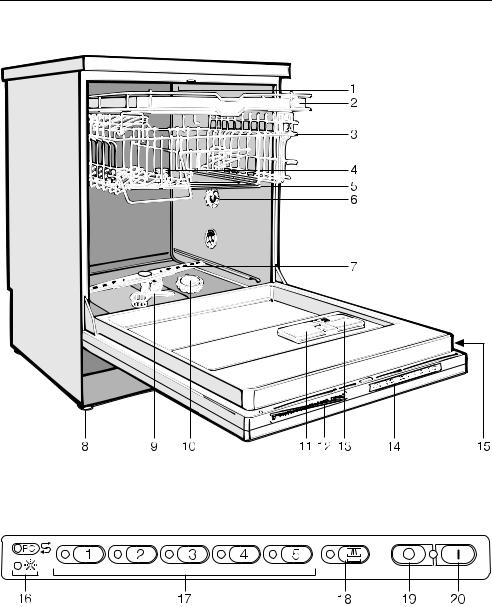
Guide to the appliance
View of the machine
Control panel (12)
4

Guide to the appliance
1Upper spray arm (not visible)
2Cutlery tray
3Upper basket
4Water guide duct for middle spray arm
5Middle spray arm
6Water hardness selector
7Lower spray arm
8Four height adjustable levelling legs
9Combination filter
10Salt reservoir
11Dual compartment detergent dispenser
12Control panel
13Rinse aid reservoir (with dosage selector)
14Adhesive label with programme names
15Data plate
16Indicator lamps
17programme touch pads
18Top Solo touch pad
19O - OFF touch pad
20I - ON touch pad
Note: Lower basket is not shown.
Programme label
An adhesive label listing the programme names is supplied with the dishwasher. It should be placed in the indented area next to the programme touch pads.
Make sure that the indented area is free of dust and grease.
Remove the backing from the label and place it into the indented area.
Remove the protective cover from the label.
Indicator lamps
8k “Add salt” indicator lamp
H“Add rinse aid” indicator lamp
Programme touch pads
bUNIVERSAL 65 °C / 150 °F
cUNIVERSAL 55 °C / 130 °F
dECONOMY 55 °C / 130 °F
eCHINA & CRYSTAL 45 °C / 115 °F
fNORMAL 55 °C / 130 °F
2Top Solo
oOFF - touch pad
gON - touch pad
5

IMPORTANT SAFETY INSTRUCTIONS
WARNING
When using your dishwasher, follow all basic safety precautions.
This appliance conforms to all uniform safety codes and regulations. To avoid injury and machine damage, read the operating instructions carefully before using the dishwasher.
The manufacturer cannot be held responsible for damage or injury caused by improper use or for uses other than those for which the appliance is intended.
This dishwasher is intended exclusively for cleaning domestic croc-
kery and cutlery in a domestic household. Do not use for purposes other than those for which it was designed. Any other applications may be dangerous.
Repairs should only be carried out by qualified personnel. Disconnect
the appliance from the power supply before servicing (pull out the plug or turn off the circuit breaker).
Only install the dishwasher under a continuous countertop which is se-
cured to adjacent cabinetry.
The dishwasher must be electrically grounded. Install the dish-
washer as per the included Installation instructions.
Use only detergents and rinse aids recommended for dishwashers.
Do not use commercial or industrial grade detergents, as these may
cause adverse chemical reactions and damage the machine. Use detergents made for residential dishwashers only.
Do not use your dishwasher unless all enclosure panels are properly in
place.
Do not let small children play with the dishwasher and its controls or
operate it.
There is a danger that children playing might shut themselves in the dishwasher. Please supervise its use by the elderly or infirm.
FOR HOUSEHOLD USE ONLY
6

IMPORTANT SAFETY INSTRUCTIONS
Keep all detergents and rinse aids out of the reach of children.
Dishwasher detergents contain Sodium Silicate and Sodium Carbo-
nate. In case of eye contact, immediately flush with water. Call a physician or poison control.
Do not tamper with the controls.
Do not drink the water from the wash cabinet.
When loading items to be washed:
–Locate pointed items so that they are not likely to damage the door seal.
–Load knives with the cutting edge down to reduce the risk of injuries.
Do not wash plastic items unless they are labeled “dishwasher safe”
or the equivalent. For items not labeled, check the manufacturer’s recommendations.
Do not abuse, sit, or stand on the door or dishracks of the dish-
washer.
Remove the front door and cut off the power cord of the dishwasher before removing it from service or discarding it. This will help protect child-
ren from injury and accidentally locking themselves in.
Under certain conditions, hydrogen gas may be produced in a
hot water system that has not been used for two weeks or more. HYDROGEN GAS IS EXPLOSIVE. If the hot water system has not been used for such a period, turn on all hot water faucets and let the water flow from each for several minutes before using the dishwasher. This will release any accumulated hydrogen gas. Do not smoke or use an open flame during this time.
For safety reasons do not operate this appliance on an extension
cable. Danger of overheating.
A damaged appliance is dangerous. Switch off the mains and
call the Service Departement for assistance.
Dishwashers with heating element
Do not touch the heating element during or immediately after use.
SAVE THESE INSTRUCTIONS
7

Caring for the environment
Disposal of the packing material.
The packaging material protects the appliance during shipping. It has been deliberately designed to be biodetergradable and recyclable. Please dispose of these materials as you would any other recyclable products.
Disposal of your old machine.
Old machines contain materials which can be recycled. Please contact your local recycling center or scrap merchant about the possibility of recycling these materials and make certain the machine has been made child resistant as outlined in the “Important safety instuctions”, before disposing of the appliance.
Energy saving washing.
These dishwashers are exceptionally efficient in their use of water and electricity. You can make the most of your appliance by following these tips:
Make full use of the baskets without overloading the dishwasher for the most economical washing.
For small loads:
Select the “Top Solo” function (see “Additional features” chapter).
Choose a programme that best suits the degree of soiling and the type of dishes being washed.
If baskets are only half full, use the ECONOMY programme.
Use the correct amounts of detergent and rinse aid.
8

Before using for the first time
Before using for the first time please note the following points:
Setting the water softener.
The water softener must be set to correspond to the water hardness in your area. This can be obtained from your local water company, or by using a test kit that can be purchased from the Miele Parts Department (part no. 0014619).
The salt reservoir must only be filled with water and salt. Never fill it with detergent.
Adding rinse aid.
Inadvertently filling the rinse aid reservoir with liquid or powder detergent will damage the reservoir.
Only use detergents and rinse aids formulated for domestic dishwashers.
Add the correct amount of detergent.
Follow the recommendations on page 26 to determine how much detergent to use. Not enough or too much detergent can lead to poor wash results.
Overdosing, in combination with soft water and high water temperatures, can lead to cloudy glassware.
Cleaning results vary from brand to brand. If you are not satisfied with the results from one brand, try another quality brand before contacting the Miele Service Department for advice.
It is important to choose the correct programme.
Different wash programmes should be selected for different loads and different degrees of soiling. See the programme chart for further programme descriptions.
When the dishwasher is run for the first time, the selected programme will not start for approximately 7 minutes.
During these 7 minutes, the Water softener reactivation programme is run, and the 8k indicator lamp will be on.
Load the dishes correctly.
Load the dishes so that water can contact all surfaces. Ensure that the spray arms are not blocked by items which are too tall for the basket or which extend through the bottom of the basket. If necessary, manually rotate the spray arms to test for clearance.
The combination filter in the base of the wash cabinet and the spray arms must be kept clean.
The spray arms and the filters should be periodically checked and cleaned if necessary.
See the corresponding chapters for detailed information on the above points.
9
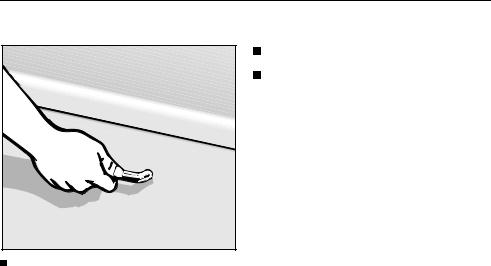
Opening and closing the door
To open the door. |
To close the door |
Push the baskets in.
Lift the door and push until it clicks closed.
Pull on the handle.
If the door is opened during operation, all machine functions will automatically be interrupted.
Note:
To open the dishwasher door if the front panel has not yet been installed, see Step 3 of the “Installation” instructions, found later in this manual.
10

Water Softener
If the water hardness in your area is under 150 ppm (mg/l) you should not activate the built-in water softener with salt. This could lead to problems including cloudy glassware.
The water hardness in your area can be obtained from your local water company or by using a test kit that can be purchased from the Miele Parts Department (part no. 0014619).
If your water hardness is above 150 ppm (mg/l), the water should be softened to avoid the build up of calcium deposits on dishes, cutlery and in the dishwasher.
The dishwasher is factory set for a hardness level of 20 - 70 ppm (mg/l). If your water is harder or softer, the setting will need to be adjusted.
To ensure a steady supply of softened water, the built in water softener must be:
1.Correctly set.
2.Reactivated with salt when depleted.
Where the water hardness fluctuates (e.g. 140 - 310 ppm (mg/l)) always set the machine to the lower value
(140 ppm (mg/l) in this example).
Programming Table (see next page for programming instructions)
|
|
|
|
|
touch pad/ |
Selector |
ppm |
gr/Impgal |
indicator |
setting |
|||
(mg/l) |
|
|
|
lamp |
(internal) |
|
|
|
|
|
|
|
|
*20- |
70 |
1.4 |
- |
4.9 |
b |
6 |
|
|
|
|
|
|
|
90- |
110 |
6.3 |
- |
7.7 |
c |
6 |
|
|
|
|
|
|
|
|
130 |
|
|
9.2 |
d |
6 |
|
|
|
|
|
|
|
140- |
180 |
9.8 |
- |
12.6 |
e |
6 |
|
|
|
|
|
|
|
200- |
220 |
14.0 |
- |
15.4 |
f |
6 |
|
|
|
|
|
|
|
|
230 |
|
|
16.1 |
2 + b |
6 |
|
|
|
|
|
||
250290 |
17.5 |
- 20.4 |
2 + c |
6 |
||
|
|
|
|
|
||
310400 |
21.8 |
- 28.1 |
2 + d |
6 |
||
|
|
|
|
|
||
410630 |
28.8 |
- 44.2 |
2 + e |
6 |
||
|
|
|
|
|
||
650850 |
45.6 |
- 59.6 |
2 + f |
4 |
||
|
|
|
|
|
||
860-1170 |
60.4 |
- 82.1 |
2 + f |
5 |
||
|
|
|
|
|
||
1190-1260 |
83.5 |
- 88.4 |
2 + f |
6 |
||
|
|
|
|
|
|
|
* factory setting
11

Water Softener
Programming the water hardness
The Programme touch pads are used |
The “8k” indicator lamp will flash |
to set the water hardness. Each pad |
as long as you are in the programming |
can be used alone (level 1) or in combi- |
mode. |
nation with the “Top Solo”pad (level 2) |
|
to programme the hardness to the |
|
valve determined using the Programm- |
|
ing Table on the previous page. |
|
For example, to set a level 1 value |
|
(from 20 - 220 ppm (mg/l)), only a num- |
|
bered Touch pad will have to be |
|
pressed. |
|
To programme a level 2 value (from 230 |
|
- 1260 ppm (mg/l)), both the “Top Solo” |
|
pad and a numbered Touch pad will |
|
have to pressed. |
|
12

Water Softener
To programme the water hardness, proceed as follows:
Open the door.
Turn off the dishwasher.
Press and hold buttons b and d while simultaneously turning on the dishwasher. The “ON” indicator lamp will light and the “8k”and c lamps will flash.
The “8k” indicator lamp will flash as long as you are in the programming mode.
If any other indicator lamps flash, turn off the dishwasher and start again.
Depending upon what “Additional Features” are currently programmed into your machine, other indicator lamps may also illuminate. These should be ignored for the time being.
Press Touch pad c to enter the data entry mode. The c indicator lamp will stop flashing and go out. (Exception: if a hardness level of 90 -110 ppm (mg/l) has been set previously , the c indicator lamp will stop flashing and remain lit).
A)If your Water hardness is 220 ppm (mg/l) or less, press the touch pad that corresponds to the level you want to set (see the Programming Table on the previous page). As long as the selected pad is depressed, its indicator lamp will remain lit. When the touch pad is released, the c lamp will once again flash.
OR
B)If your Water hardness is greater than 220 ppm (mg/l), press 2 to access programme level 2 first (its indicator will light), then press the required numeric touch pad. Once the numeric pad is released, the c will once again flash.
Example:
If the water hardness is 450 ppm (mg/l), press 2 first, then press the e touch pad. When e is released, the c indicator will flash.
Press 2 once to enter the setting; its indicator will light up.
Press 2 once more to store the setting in memory. The 2 indicator will flash if the value has been stored correctly.
Turn off the dishwasher. The water hardness is now programmed.
13

Water Softener
To check the programmed water hardness:
Open the door.
Turn off the dishwasher.
Press and hold buttons b and d while simultaneously turning on the dishwasher. The “ON” indicator lamp will light and the “8k” and c lamps will flash.
If any other indicator lamps flash, turn off the dishwasher and start again.
Depending upon what “Additional Features” are currently programmed into your machine, other indicator lamps may also illuminate. These should be ignored for the time being.
Press Touch pad c to check the water softener setting currrenty stored.
If a water hardness between 20 and 220 ppm (mg/l) is stored, the indicator lamp next to the corresponding touch pad will illuminate (see the Programming Table). If no lamp lights up, a hardness level greater than 220 ppm (mg/l) was set. In this case:
Press the 2 button. The indicator lamp that corresponds to the stored hardness level will illuminate.
Turn off the dishwasher.
14
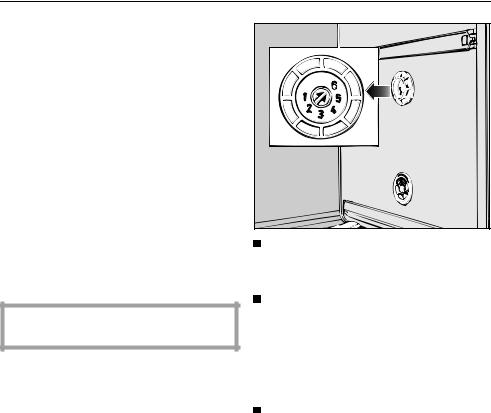
Water Softener
Setting the water hardness selector inside the wash cabinet.
The water hardness selector is factory set to position 6. It should only be reset if your water hardness is in the range of 650 - 1170 ppm (mg/l).
|
|
|
|
|
water |
ppm |
gr/Impgal |
hardness |
|||
(mg/l) |
|
|
|
selector |
|
|
|
|
|
|
(Position) |
|
|
|
|
|
|
20- |
630 |
1.4 |
- |
44.2 |
6* |
|
|
|
|
|
|
650- |
850 |
45.6 |
- |
59.6 |
4 |
|
|
|
|
|
|
860-1170 |
60.4 |
- |
82.1 |
5 |
|
|
|
|
|
|
|
1190-1260 |
83.5 |
- |
88.4 |
6* |
|
|
|
|
|
|
|
* = factory setting
Do not set the selector on positions 1 - 3.
Using a screwdriver, remove the cover from the water hardness selector.
Using a coin or screwdriver, turn the selector dial to the desired setting.
Example:
If the water hardness is 670 ppm (mg/l), set the selector to position 4 (650 - 850 ppm (mg/l)).
Replace the cover on the water hardness selector.
15
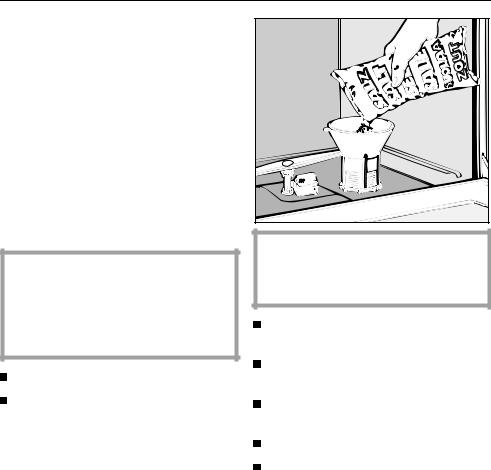
Water Softener
Filling the salt reservoir.
The salt reservoir should be filled before the first use and whenever the “8k” indicator lamp lights up. Use water softener reactivation salt
(1 - 4mm grain size), as other salts may contain insoluble additives which can impair the functioning of the softener and settle on glassware.
We recommend “Somat” salt (2kg) available from Miele (article no. 21997603).
The salt reservoir holds approx. 2 kg (4 lbs) of salt.
Inadvertently filling the salt reservoir with dishwashing detergent will damage the water softener. Make sure that only water softener reactivation salt of the proper grain size is used
Remove the lower basket.
Unscrew and remove the salt reservoir cap.
Before filling the salt reservoir for the first time:
Fill the salt reservoir with approximately 2 litres (2 qts) of water.
Place the funnel (provided) over the salt reservoir.
Carefully fill with salt. As it is filled, water will run out .
Clean any excess salt from the threads of the reservoir opening.
Screw the cap on firmly.
Run the UNIVERSAL programme immediately to remove any traces of salt from the cabinet.
16
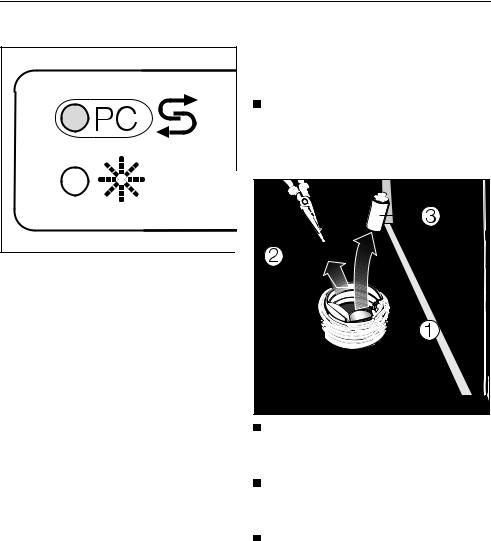
Water Softener
Salt indicator.
When the salt reservoir is empty, the “8k” indicator lamp will light, notifying you that the reservoir should be refilled with reactivation salt.
Once filled, the dishwasher will automatically reactivate the softener when necessary. The “8k” indicator lamp will light up whenever the reactivation process is being performed.
Note:
If the water used is very soft (below 150 ppm (mg/l)), further softening is not required and the “8k” indicator lamp will remain lit. It can be disregarded or bypassed using the following procedure.
The “8k” button has also been designed for future programme updates (PC). See the “After Sales Service” section for further details.
Bypassing the Salt indicator lamp.
In order to bypass the salt indicator lamp, you will need a screwdriver and needle nose pliers.
Remove ONLY the salt reservoir cap.
Looking into the salt reservoir, you will see the top of the float chamber on the right hand side b.
Using a screwdriver, carefully pivot the float chamber towards the center of the reservoir.
Using the needle nose pliers, first pull the cap c off of the float chamber, then remove the float d.
Replace the float chamber cap, push the chamber back into its upright position, and replace the salt reservoir cap. The indicator lamp will now remain off.
17
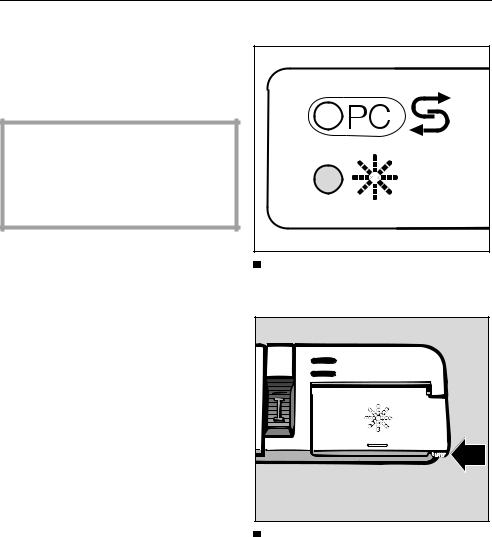
Adding rinse aid
The use of Rinse Aid (for example, Jet-Dry®) is recommended to prevent spotting on dishes and glassware that normally occurs during the drying phase of automatic dishwashing, as well as to aid the drying result.
Inadvertently filling the rinse aid reservoir with detergent always leads to damage to the reservoir. Only pour rinse aid formulated for residential dishwashers into the reservoir.
Adding rinse aid.
Add Rinse Aid before the first use and anytime the H indicator lamp comes on.
Press the button in the direction of the arrow until the flap springs open.
18
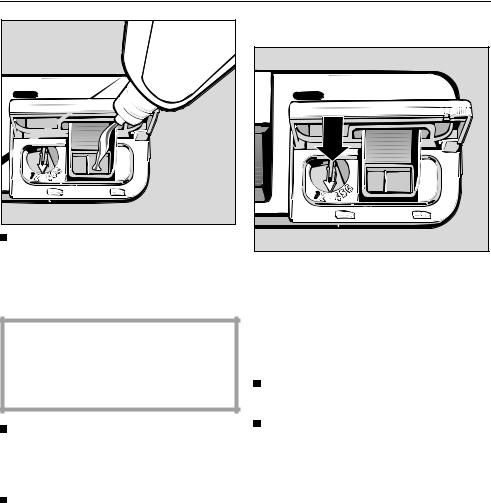
Adding rinse aid
Setting the dosage.
Pour liquid rinse aid into the storage container until it is visible on the surface of the screen. Do not add any more rinse aid until the H indicator lamp comes on.
Only use rinse aid specifically labeled for residential dishwashers. Inadvertently using powder or liquid detergents will damage the rinse aid dispenser.
Close the flap firmly. The flap must audibly engage, otherwise water could get into the rinse aid storage container during the programme.
Wipe up any spilled rinse aid. This prevents over-foaming occuring during the next programme.
The flap should remain closed during normal operation.
The dosage selector comes factory set to 3. The setting dispenses approximately 3 ml rinse aid per programme. It can be adjusted from 1 to 6, depending on your requirements. It is best to use the lowest setting that will still give good results for your water supply.
If spots appear on dry glassware, use a higher setting.
If streaking appears on dishes or glasses, use a lower setting.
19
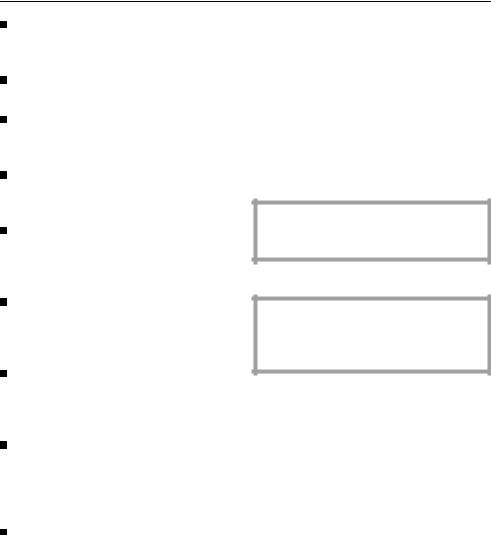
Loading the dishwasher
Scrape food and other solid waste such as bones and pits from dishes, but do not rinse.
Load the dishes so that water can reach all surfaces.
Do not place dishes and cutlery inside other pieces where they may be concealed.
Hollow items such as cups and glasses should be inverted and placed in the upper basket.
Concave based items should be placed at an angle so that water can run off them freely, or placed on top of the coffee bar (see page 23).
Tall, narrow, hollow pieces should be placed in the center of the basket, rather than in the corners, to ensure water coverage.
Small cups and glasses should be placed on the cup racks. Taller mugs and glasses can be placed underneath the rack.
The spray arms must not be blocked by items which are too tall or hang through the baskets. If in doubt, test for free movement by manually rotating the spray arms.
Some food items may contain natural dyes that can discolor plastic items in the dishwasher ( e.g. carrots, tomatoes, ketchup, etc.). The stability of plastic items is not affected by this discoloration. It will gradually disappear over time.
Some loading examples are shown on the following pages.
Note
If the additional feature “Top Solo” has been selected with a wash programme, all items must be loaded into the upper basket and cutlery tray. See the “Additional features” section for further information.
Do not touch the heating element during or directly after the end of a programme as it may still be hot.
In areas where the water has high mineral content, it may be necessary to polish silverware after washing to achive a high shine.
20
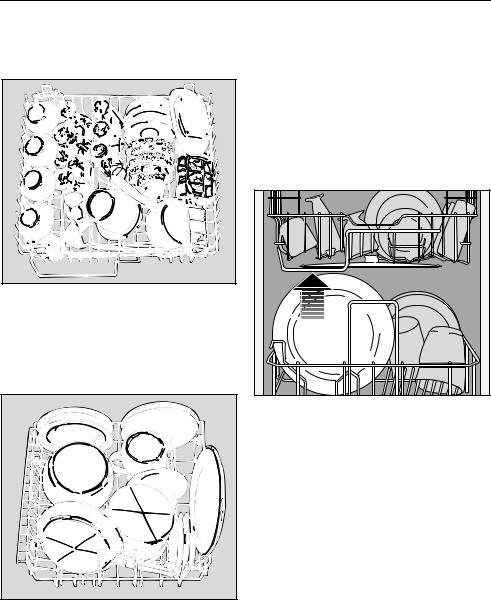
Loading the dishwasher
Loading examples.
Upper basket.
For small, lightweight, or delicate items such as cups, saucers, glasses, dessert bowls, etc. and also heat sensitive plastic ware.
Bottom basket.
For larger and heavier items such as plates, serving platters and saucepans. Glasses should only be placed in the bottom basket if the special glassware insert is used.
The plate inserts on the left and right rear of the lower basket are removable. To remove, push the handles of both inserts toward the inside of the basket. Once removed, the open area can accommodate large pots, casserole dishes, or accessory inserts (see “Accessories”).
Height limit
The height guard at the base of the upper basket is there to protect the middle spray arm. No object placed in the lower basket should stand higher than this guard.
21
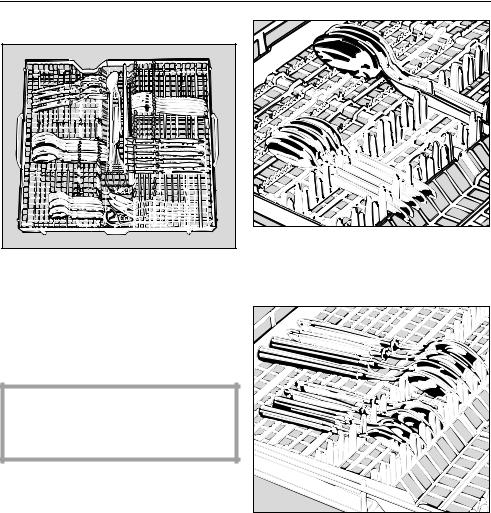
Loading the dishwasher
Cutlery tray.
To make unloading easier, cutlery can be grouped in zones, one for knives, one for forks, etc.
Larger items like sauce ladles, cake slices, long knives and mixing spoons can be placed lengthwise in the trough in the centre of the tray.
Make sure the upper spray arm can rotate freely after sliding in the cutlery tray. Rearrange any items that are in its way.
The cutlery tray insert is removable (depending on model).
Ensure that spoon heads are in contact with at least one of the grips in the cutlery tray. This way they cannot collect water.
Cutlery with round or oval handles should be placed with the heads in the grips as this prevents item slipping.
If putting the spoons this way round, make sure the spoon heads touch at least one of the strips on the floor of the tray, so that the water still runs off.
22
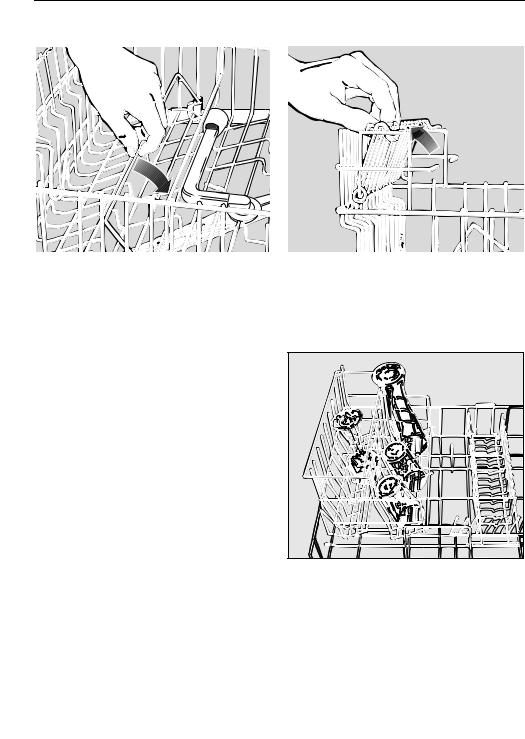
Loading the dishwasher
|
Coffee bar. |
Adjustable cup racks. |
|||
|
|
|
|
|
|
|
|
|
|
|
|
|
|
|
|
|
|
|
|
|
|
|
|
Place coffee mugs on top of the bar so that they sit at a slant. This allows all water to run off the base of the mug. The bar can also be used as a seperator between two rows of glasses keeping them from leaning against each other. This protects the glasses and ensures good wash results. For wide items, flip the bar over to the right.
To make room for tall glasses, raise the rack upwards. Lower it to double stack smaller items.
Insert for glasses
The glassware insert can be installed in the left or right side of the bottom basket in place of the removable plate insert.
Very tall glasses can then be loaded vertically so that they are washed more effectively.
23
